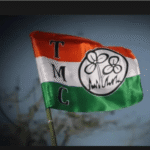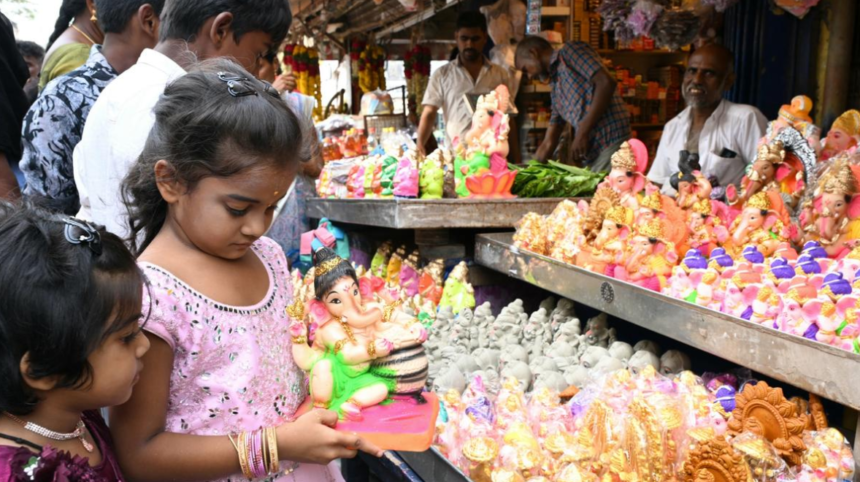Vinayaka Chathurthi, one of the most widely celebrated Hindu festivals, reverberated with energy and devotion across India, bringing communities together in prayer, joy, and cultural expression. The festival, dedicated to Lord Ganesha, the remover of obstacles and the harbinger of wisdom, marks the birth of the beloved elephant-headed deity. With elaborate decorations, rituals, music, and dance, the ten-day festival saw temples, households, and public spaces come alive with vibrant celebrations.
Prominent Ganesha temples such as the ones at Pillayarpatti in Sivaganga and Malaikottai in Tiruchirappalli, Tamil Nadu, as well as the iconic Manakula Vinayakar temple in Puducherry, were teeming with devotees. Leaders from all walks of life also joined the celebrations, emphasizing the unity and spiritual fervour that this festival brings to people across the country. This year’s celebrations, marked by grand processions, eco-friendly idols, and cultural festivities, showcased the deep-rooted reverence for Lord Ganesha, transcending regional and social barriers.
1. The Significance of Vinayaka Chathurthi
Vinayaka Chathurthi, also known as Ganesh Chaturthi, is a significant Hindu festival that celebrates the birth of Lord Ganesha, the son of Lord Shiva and Goddess Parvati. According to Hindu mythology, Ganesha is worshipped as the remover of obstacles, the god of new beginnings, wisdom, and intellect. His elephant head symbolizes knowledge, and his pot-bellied body signifies prosperity and the acceptance of all circumstances, making him one of the most revered deities in the Hindu pantheon.
Celebrated with grandeur, particularly in Maharashtra, Karnataka, Tamil Nadu, Andhra Pradesh, and Telangana, Vinayaka Chathurthi has transcended religious boundaries, becoming a cultural festival that fosters community bonding. The festival spans ten days, beginning on the fourth day of the waxing moon in the Hindu month of Bhadrapada (August-September). Idols of Lord Ganesha are worshipped in homes and public pandals, with the immersion (Visarjan) of the idols marking the conclusion of the celebrations.
2. Celebrations Across Tamil Nadu
In Tamil Nadu, Vinayaka Chathurthi holds special significance, with temples and homes alike adorned with grand decorations for the occasion. The festivities began with early morning rituals, where devotees offered prayers and performed aarti (ceremonial worship) to invoke the blessings of Lord Ganesha. The day is characterized by the chanting of hymns, recitation of the Ganesh Chalisa, and the offering of traditional delicacies like modak, which is said to be Ganesha’s favourite sweet.
Pillayarpatti Temple in Sivaganga
Pillayarpatti, a small village near Sivaganga in Tamil Nadu, is home to one of the oldest and most revered temples dedicated to Lord Ganesha. The Karpaga Vinayagar Temple, more commonly known as the Pillayarpatti Temple, houses an ancient rock-cut idol of Lord Ganesha, believed to be over 1,600 years old. During Vinayaka Chathurthi, the temple is a focal point for thousands of devotees who flock to seek the blessings of Lord Ganesha.
The temple’s idol, known as Karpaga Vinayagar, is a unique representation of Ganesha seated in a yogic posture, with two arms rather than the usual four. The temple is renowned for its serene atmosphere and the spiritual experience it offers to pilgrims. This year’s Vinayaka Chathurthi saw the temple brimming with devotees from across Tamil Nadu and beyond, who participated in special pujas (rituals) and ceremonies that continued throughout the day.
The temple priests performed elaborate rituals, including the abhishekam (bathing of the idol) with milk, honey, and sacred water, followed by the offering of garlands and prayers. The entire temple was adorned with flowers and lamps, creating an aura of divinity and peace. The streets surrounding the temple were bustling with stalls selling religious items, sweets, and souvenirs, adding to the festive spirit.
Malaikottai Temple in Tiruchirappalli
The Malaikottai (Rockfort) Ganesha Temple, perched atop a rocky hill in Tiruchirappalli, is another significant site of Vinayaka Chathurthi celebrations. The temple, dedicated to Lord Ganesha, attracts a massive crowd of devotees who undertake the climb up the hill to offer their prayers. The view from the temple, combined with the spiritual significance of the location, creates an overwhelming sense of reverence for Lord Ganesha.
The celebrations at the Malaikottai Temple began at dawn, with devotees offering flowers, coconuts, and sweets to the deity. The temple’s priests conducted special prayers and aarti, while chants of “Ganapati Bappa Morya” echoed through the surroundings. The hilltop temple was beautifully illuminated, and the entire area was decked with colorful lights, enhancing the spiritual experience for those in attendance.
3. Manakula Vinayakar Temple in Puducherry
In the neighboring Union Territory of Puducherry, the Manakula Vinayakar Temple stands as a beacon of faith and devotion. This temple, dedicated to Lord Ganesha, is not only a religious site but also a cultural landmark that attracts tourists and devotees alike. The temple’s history dates back to the time of French colonial rule, and it has since remained a hub of spiritual activities in the region.
On the occasion of Vinayaka Chathurthi, the Manakula Vinayakar Temple witnessed a sea of devotees eager to offer their prayers and participate in the rituals. The temple’s festivities included the traditional Ganesh puja, abhishekam, and the distribution of prasad (blessed offerings) to devotees. The idol of Lord Ganesha was adorned with intricate flower garlands, and the temple precincts were decorated with colorful rangolis (patterns made on the floor with colored powders).
What makes the Manakula Vinayakar Temple unique is the presence of the temple elephant, Lakshmi, who is a significant attraction for visitors. The elephant, considered sacred, offers blessings to devotees by gently placing her trunk on their heads, a ritual that holds deep spiritual meaning for those seeking divine intervention in their lives. The festive atmosphere was heightened by the participation of people from all walks of life, showcasing the inclusivity and cultural richness of Vinayaka Chathurthi celebrations.
4. Leaders and Celebrities Join the Celebrations
Vinayaka Chathurthi is not only a religious festival but also a symbol of unity and cultural pride. This year, political leaders, celebrities, and public figures from various states actively participated in the celebrations, emphasizing the festival’s importance as a unifying force in Indian society.
In Tamil Nadu, Chief Minister M.K. Stalin and other prominent leaders offered their prayers at Ganesha temples, sending messages of peace and prosperity to the public. Similarly, in Maharashtra, which is renowned for its grand Vinayaka Chathurthi processions, political leaders like Uddhav Thackeray and Devendra Fadnavis attended the festivities in Mumbai, underscoring the significance of Lord Ganesha in Maharashtra’s cultural and religious identity.
Celebrities from the Indian film industry also took part in the celebrations, with actors such as Rajinikanth, Akshay Kumar, and Deepika Padukone sharing pictures of their family rituals and idol installations on social media. These public figures not only celebrated the festival with fervour but also used their platforms to promote eco-friendly practices, urging their fans to adopt sustainable ways of celebrating by using clay idols and minimizing environmental impact during the Visarjan.
5. Eco-Friendly Ganesha: A Growing Trend
In recent years, the celebrations of Vinayaka Chathurthi have seen a growing emphasis on eco-friendly practices, with awareness campaigns promoting the use of biodegradable materials for idol-making and discouraging the use of harmful chemicals and plastics. The environmental impact of the festival, particularly during the immersion of idols in water bodies, has been a matter of concern for environmentalists.
This year, the emphasis on eco-friendly celebrations was more pronounced than ever, with several communities opting for clay idols that dissolve easily in water, causing minimal harm to marine life. In cities like Chennai, Bengaluru, and Hyderabad, awareness drives were conducted to encourage devotees to use natural colours and materials for decorations, ensuring that the festival remains joyful while being environmentally responsible.
Several NGOs and environmental groups collaborated with local authorities to set up designated immersion sites with artificial ponds, ensuring that the immersion process was controlled and did not pollute natural water bodies. The message of sustainability resonated with devotees, who embraced the concept of celebrating responsibly without compromising on the spiritual essence of the festival.
6. Cultural Performances and Community Bonding
Vinayaka Chathurthi is not just about religious rituals; it is also a celebration of Indian culture and heritage. Cultural performances, including traditional music and dance, form an integral part of the festivities, bringing communities together to celebrate the spirit of Ganesha. In public pandals, artists performed classical dance forms like Bharatanatyam and Kathak, while musicians played devotional songs and bhajans dedicated to Lord Ganesha.
In several cities, community kitchens were set up to serve free meals (Annadanam) to devotees, reflecting the spirit of sharing and community bonding that the festival promotes. Vinayaka Chathurthi also provided an opportunity for people from different social and economic backgrounds to come together, fostering a sense of unity and collective celebration.
Conclusion
Vinayaka Chathurthi 2024 was celebrated with immense fervour and devotion across India, with Ganesha temples in Tamil Nadu and Puducherry playing a pivotal role in the festivities. The festival brought together people from all walks of life, reinforcing the values of unity, inclusivity, and cultural pride. The growing emphasis on eco-friendly practices further highlighted the evolving nature of the celebrations, ensuring that the festival remains in harmony with the environment while preserving its spiritual and cultural significance.
As the festival concludes with the immersion of Ganesha idols, devotees look forward to another year of prosperity, wisdom, and happiness, awaiting the return of Lord Ganesha with the chant of “Ganapati Bappa Morya, Pudhchya Varshi Lavkar Ya” – a prayer for the beloved deity to return next year, bringing more joy and blessings. ALSO READ:- Jaishankar’s 6-Day Diplomatic Mission: Strengthening Ties with Saudi Arabia, Germany, and Switzerland





